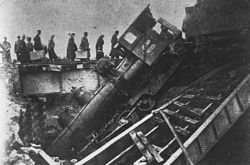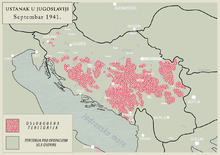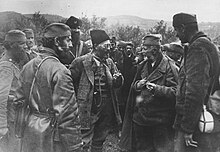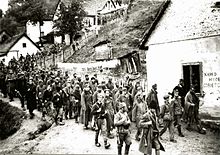Uprising in Serbia (1941)
This article has multiple issues. Please help improve it or discuss these issues on the talk page. (Learn how and when to remove these template messages)
|
| Uprising in Serbia | ||||||||
|---|---|---|---|---|---|---|---|---|
| Part of World War II in Yugoslavia | ||||||||
 Destroyed German train in Serbia, 1941 | ||||||||
| ||||||||
| Belligerents | ||||||||
|
|
|
| ||||||
| Commanders and leaders | ||||||||
|
|
|
| ||||||
| Casualties and losses | ||||||||
| 4,000 Chetniks & Partisans[3] |
200 killed 400 wounded[4] | |||||||
| 35,000 rebels and civilians massacred in reprisals[5] | ||||||||



The Uprising in Serbia was initiated in July 1941 by the
As the uprising progressed, the ideological rift between the two factions became more and more obvious. On one side the Chetnik detachments considered themselves loyal to the royal government in exile and fought for the restoration of pre-war order. On the other side, members of the Peoples Liberation Army of Yugoslavia favored the introduction of
The Germans soon gathered a large force and quelled the uprising using mass terror, but the remaining Partisan forces crossed into
Background

Preparations for the uprising
Communists

Preparations for the uprising by the
The German
The entrance of the USSR into the war strengthened the hope of the Serbian people, who traditionally saw Russia as protector of Serbia, as well as optimism that the war would be over soon.

Decision for preparing struggle in Serbia issued on June 23, 1941 at the meeting of the Provincial Committee for Serbia, which was attended by
On July 5, a communist party proclamation appeared that called upon the Serbian people to struggle against the invaders. The Serbian people were reminded of their glorious past, and called upon to side with "invincible Slavic Russia" headed by
Chetniks

Yugoslav Army colonel
Mihailović believed that the war would not end soon. He made his first public appearance at a village fair in Tometino Polje on 28 June, where he announced to the gathered people that preparations for armed combat were in place, but the moment for its beginning hadn't yet come.[citation needed]
Resistance begins

Western Serbia was chosen as the base for the uprising, due to its forests and hilly terrain, and a population which had provided strong resistance to invading
For the beginning of the uprising the Rađevina partisan detachment took armed action on 7 July 1941 in
Spread of the uprising
The uprising spread from western Serbia to other parts of Serbia. During July and August many Party and SKOJ proclamations that called for armed struggle were printed. Communist groups cut communication lines along railways between Niš and Leskovac. The main power line of Radio Belgrade was cut already on 4 July. Saboteurs in Belgrade set fires on German trucks, garages and trains.
The Commissariat of Interior registered 220 incidents of sabotage in July. Attacks were carried out on police and gendarmerie stations, seats of local governments, rail lines. The village of
Chetniks join the uprising

When the organized partisan struggle begun, a few ex-Army commanders, originally without Mihailović's approval, carried by the wave of the uprising, took part in combat. Mihailović didn't want to start his uprising, preferring to wait and build up his forces, waiting for a favourable moment. He thought that Germans were stronger in every way and resistance was futile and counter-productive. Participation of Chetnik forces in the uprising was largely forced by fear that the partisans would gain influence among the Serbian people. Former officers couldn't stand to watch how young boys and laymen from ranks of teachers, students, workers and peasants were waging battles. This was particularly true of officers who were compromised by their poor performance during the Axis invasion four months earlier and whom civilians considered incompetent cowards.
In late August Mihailović ordered the creation of Chetnik detachments, mase up of recruits 20–30 years old. Their assignment would be to take power at the moment of popular uprising. Mihailović proclaimed himself the legitimate representative of the Yugoslav Royal Army and, on basis of Yugoslav law, demanded the enlistment of reservists 30–40 years old. These Chetnik units had an assignment to prevent pillaging and unnecessary violence, and at the same time, the actions of "destructive elements" (Communists).[10]
At the end of August the first contacts were made between Partisans and Chetniks. Already on August 25, an agreement on joint attacks had been made by the commander of the Podrinje Partisan detachment and Captain Dragoslav Račić, a commander of the Cer Chetnik detachment. Joint Partisan-Chetnik actions against German forces came to the fore during taking of Krupanj and Gornji Milanovac, the battle of Šabac and the sieges of Valjevo and Kraljevo.
Battle of Loznica
Chetnik insurgents launched a surprise attack on the occupied town of Loznica on the morning of 31 August 1941, after the Germans refused the invitation to surrender sent by courier the previous night. Fighting for Loznica was the largest armed conflict with the Germans in occupied Yugoslavia until then.[11]
Capture of Banja Koviljača

Battle of Krupanj
After three days of fighting, Krupanj was liberated on September 3, 1941 by the Valjevo Partisan detachment and Chetniks led by Orthodox priest Vlada Zečević and his lieutenant Ratko Martinović.[14] Zečević, Martinović and bulk of the Chetniks later joined the partisans.
Liberation of Užice
This section is empty. You can help by adding to it. (April 2013) |
Battle of Šabac

Nebojša Jerković, a commander of the Mačva Partisan detachment, visited Chetnik captain Dragoslav Račić, a commander of the Cer Corps, to reach agreement on a joint attack on Šabac.[15] The Battle of Šabac lasted from September 22 until September 24, when the 342nd German Division came in aid to the besieged Germans and broke the rebel encirclement. German soldiers, retaliating. killed some 1,000 men from Šabac and Mačva.[16] The number of soldiers in the Mačva Partisan detachment dropped to half its initial forces. Deployment of the 342nd German Division in the Mačva operation marked the beginning of a big German counter-offensive on liberated territory.
Battle of Kruševac
The fighting between attacking rebel forces and Axis garrison lasted for four days.[17]
On the first day Keserović's Rasina Detachment attacked the Kruševac garrison from Bagdala and Rasina.[18] The Chetniks of the Rasina Detachment pushed the Germans from their positions on the town's periphery to its center and blocked them in three buildings in the town center.[18] The Partisan Rasina Detachment was positioned between Obilićevo and the railway in Dedina and was unable to join the initial surprise attack of Chetnik forces on the first day.[19] As soon as the attack on Kruševac began, Kosta Pećanac insisted to cancel it and to cancel the alliance between Chetniks and Partisans.[20] In his order issued on 23 September and in his appeal to Serbs issued on 24 September, Pećanac condemned his own units that participated in the attack on Kruševac.[20]
On the second day, Keserović canceled the attack, and retreated to join other Chetnik units under Brigadier General Ljubo Novaković in their attack on Axis-held Kraljevo.[21] Therefore on the second day of the attack only the Chetnik Stalać Detachment and the small Partisan Rasina Detachment continued to attack the garrison,[18] and German forces received reinforcements: infantry, cavalry and tanks from the Niš garrison.[18]
Although the town was well defended the German garrison had 28 dead and 16 to 20 wounded soldiers, including the captain who was the commander of the German battalion and garrison.[22] On the fourth day of the battle Kosta Pećanac and a large force of Chetniks reinforced the Axis garrison.[23] The rebels gave up further attacks after having suffered 17 dead and 74 wounded.[24] Keserović and Radojević issued a resolution and condemned Pećanac and Milan Nedić as traitors and invited people to join "National liberation Chetnik detachments" (Serbian: Hационално-ослободилачки четнички одреди) en masse.[20] Pećanac sentenced Keserović and Radojević to death.[20]
Battle of Gornji Milanovac
Yugoslav Partisans and Yugoslav army in homeland (known as Chetniks) in joint action freed Gornji Milanovac from the Nazi occupation. Gornji Milanovac was merged with the other released towns of the occupied Kingdom of Yugoslavia to form the short-lived Republic of Užice. At the head of that joint action was Zvonimir Vučković. During that battle two German tanks were trapped and now one of those is a monument on the exit from the town in the village of Nevade, while the other is a monument in Užice. (Hotchkiss H35)
Battle of Čačak
This section is empty. You can help by adding to it. (April 2013) |
Battle of Kraljevo
The siege of Kraljevo was the most important battle during the Uprising in Serbia in 1941.
The rebel forces had between 3,000 and 4,000 soldiers. The battle started on 9 October 1941 when Chetniks attacked German forces near Monastery of Žiča. Several days after the battle began in a reprisal for the attack on a German garrison, the German forces committed a massacre of approximately 2,000 civilians between 15 and 20 October, in an event known as the Kraljevo massacre.
On 23 October most of the Partisan forces left the siege of Kraljevo and regrouped their forces to attack Chetniks in Čačak, Užice and Požega. The rebels organized their last larger attack on Kraljevo on 31 October, using two tanks previously captured from German forces, but failed after suffering heavy casualties.
In early November most of the Chetnik forces besieging Kraljevo retreated to reinforce their positions in other towns in Western Serbia attacked by communist forces. On 20 November 1941 both rebel formations signed a truce, only to be soon again defeated by German offensive in December 1941 that forced Partisans to leave Serbia and Mihailović and his Chetniks to flee constant German pursuit.
Republic of Užice
The
Initial German response
This section is empty. You can help by adding to it. (April 2013) |
Government of National Salvation
The Government of National Salvation, also referred to as the "Nedić regime", was the second Serbian puppet government, after the Commissioner Government, established on the Territory of the (German) Military Commander in Serbia[b] during World War II. It was appointed by the German Military Commander in Serbia and operated from 29 August 1941 to October 1944. The Nedić regime enjoyed some support.[28] The Prime Minister throughout was General Milan Nedić. The Government of National Salvation was evacuated from Belgrade to Kitzbühel, Austria in the first week of October 1944 before the German withdrawal from Serbia was complete. Nedić himself was captured by the Americans when they occupied Austria, and was subsequently handed over to the Yugoslav communist authorities to act as a witness against war criminals on the understanding he would be returned to American custody to face trial by the Allies. The Yugoslav authorities refused to return Nedić to American custody, and he died on 4 February 1946 after falling out the window of a Belgrade hospital, under circumstances which remain unclear.
Killings of civilians

The
Partisan-Chetnik split
In order to quell the uprising, Germans brought additional troops and carried out a campaign of severe reprisals against the civil population. The German actions forced Mihailović to withdraw his troops from combat, attack the Partisans and seek contact with the German administration in order to end hostilities.[33] He met with representatives of the Wehrmacht in the village of Divci. Despite his offer, the Germans replied that they would soon bring armoured units that would end the uprising and that "the German Wehrmacht cannot burden itself with allies who join it from opportunistic reasons".[34] Mihailović replied that he had to take some towns from Germans in order to prevent communists taking them, and that he didn't want to fight against the Germans. He tried to persuade the Germans of his unconditional loyalty and requested supplies for combat against the Partisans.[34] He also asked the Germans that his "patriotic actions" remain secret so as to avoid for him the fate of Kosta Pećanac, who openly made agreement with the Axis, lost any influence with the Serbian people and became considered a traitor by his own people.[34]
Despite Mihailović's offers, the Germans left him no option but unconditional surrender.[34] From that time he waged relentless war against the Partisans. Chetnik actions against Partisans in southwest Serbia at the end of 1941 were parallel or nearly parallel with German actions against Partisans.[35] The Partisan HG for Serbia issued a proclamation to the Serbian people on the treachery committed by Mihailović, saying he attacked the Partisans and sought to deceive honest Serbian peasants and Chetniks.[36]
During fights between Chetniks and Partisans in western Serbia at the beginning of November 1941, Chetniks captured a few hundred partisans. Out of this number, Chetniks gathered 365 captured Partisans and on November 13, handled them to Nedić's and German troops, who either executed them or sent them to
End of the uprising
Operation Uzice
After the offensive commenced on 20 September 1941, the Partisans initially received assistance from local
Operation Mihailovic
Aftermath
The uprising in Serbia failed to cause any serious casualties to Axis forces, which suffered 200 soldiers killed and 400 wounded. About 4,000 men of the rebels were killed during the fighting, while 35,000 civilians were killed in Serbia as victims of German reprisals.[39]
See also
- World War II in Yugoslavia
- Republic of Užice
- Operation Užice
- Kragujevac massacre
Notes
References
- ISBN 9788674030400.
Октобар, новембар и почетак децембра 1941. године, протекли су у међусобним борбама четника са шиптарским и муслиманским формацијама.
- ^ Gledović, Bogdan (1975). Istorijski zapisi. Istorijski institut SR Crne Gore c. p. 47.
- ^ Nikolić, Kosta; Stambolija, Nebojša. "Royalist Resistance Movement in Yugoslavia" (PDF). Istorija 20 veka. 2/2018. Institut za savremenu istoriju: 16. Retrieved 26 May 2020.
By the end of December 1941 around 4,000 insurgents had been killed in fighting and 35,000 hostages had lost their lives
- ^ Nikolić, Kosta; Stambolija, Nebojša. "Royalist Resistance Movement in Yugoslavia" (PDF). Istorija 20 veka. 2/2018. Institut za savremenu istoriju: 16. Retrieved 26 May 2020.
The Uprising in Serbia during the summer and autumn of 1941 did not inflict serious losses to the German army (approximately 200 German soldiers were killed and 400 were wounded). German documents show the brutality with which the Wehrmacht handled the Serbian rebellion.
- ^ Nikolić, Kosta. Mit o partizanskom jugoslovenstvu. Beograd: Zavod za udžbenike, 2015, page:337, "Само у периоду од 1. септембра до 20. децембра 1941. године убијено је најмање 35.000 људи (устаници погинули у борбама и цивили стрељани у одмаздама)."
- ^ Petranović 1992.
- ^ Marković 2004.
- ^ Proglas PK Srbije povodom napada Nemačke na SSSR
- ^ Новак Живковић, „Прва партизанска акција у Србији. Непријатељски извештај о догађајима од 7. јула 1941. године у Белој Цркви“, Архивски преглед, 1–2/1966, Београд, 1967, стр. 142.
- ^ NAREĐENJE KOMANDANTA ČETNIČKIH GORSKIH ŠTABOVA OD AVGUSTA 1941. ZA FORMIRANJE ČETNIČKIH JEDINICA
- ^ Dr I. Avakumović, Mihailović prema nemačkim dokumentima, London, 1969, 21
- ^ Mitrović 1975, p. 180"Акција четника против непријатељских гарнизона у Лозници и Бањи Ковиљачи била је у условима спровођења партизанско-четничке сарадње."
- ^ Pajić 2011.
- ^ Minić 1993, p. 244.
- ^ Dušan Trbojević, Cersko-Majevička grupa korpusa, 21–22.
- ^ "Nemački masakri u Srbiji". Archived from the original on 2014-04-18. Retrieved 2017-09-20.
- ^ (Karchmar 1973, p. 212): "The fighting went on for four days,..."
- ^ a b c d (Nikolić 1999, p. 3)
- ^ (Kovbasko 1971, p. 52)
- ^ a b c d Dimitrijević 2014, p. 72.
- ^ (Karchmar 1973, p. 212)
- ^ (Nikolić 1999, p. 1)
- ^ (Karchmar 1973, p. 212): "... but Krusevac was too well-defended, and Pecanac himself with a large force of Chetniks came to its relief."
- ^ (Nikolić 1999, p. 331)
- ^ (Давидовић 2001, p. 111)
- ^ Hehn 1971, pp. 344–373.
- ^ Pavlowitch 2002, p. 141.
- ^ MacDonald 2002, p. 142.
- ^ a b Pavlowitch 2008, p. 62.
- ^ Lampe 2000, pp. 215–217.
- ^ Kurapovna 2009, p. 167.
- ^ Tomasevich 1969, p. 370.
- ^ Izveštaj kapetana Matla pretpostavljenima od 30. oktobra 1941. o razgovorima sa predstavnicima Draže Mihailovića
- ^ a b c d Zapisnik sa sastanka Mihailovića sa nemačkim predstavnicima u selu Divci 11.11.1941.
- ^ Tomasevich & Vucinich 1969.
- ^ Zbornik NOR, tom I, knj. 2, dok. 60.
- ^ Zbornik NOR, tom XIV, 1, 76–78.
- ^ Tomasevich 1969, p. 145–155.
- ^ Nikolić, Kosta; Stambolija, Nebojša. "Royalist Resistance Movement in Yugoslavia" (PDF). Istorija 20 veka. 2/2018. Institut za savremenu istoriju: 16. Retrieved 26 May 2020.
The uprising in Serbia during the summer and autumn of 1941 did not inflict serious losses to the German army (approximately 200 German soldiers were killed and 400 were wounded). German documents show the brutality with which the Wehrmacht handled the Serbian rebellion. By the end of December 1941 around 4,000 insurgents had been killed in fighting and 35,000 hostages had lost their lives.
Literature
- Bailey, Ronald H. (1980). Partisans and Guerrillas. Vol. 12. Time-Life Books. ISBN 978-0783557199.
- Kurapovna, Marcia Christoff (2009). Shadows on the Mountain: The Allies, the Resistance, and the Rivalries That Doomed WWII Yugoslavia. John Wiley. ISBN 978-0-470-08456-4.
- Lampe, John R. (2000). Yugoslavia as History: Twice There Was a Country. CUP. ISBN 978-0521773577.
- MacDonald, David Bruce (2002). Balkan holocausts? : Serbian and Croatian victim-centred propaganda and the war in Yugoslavia ([Online-Ausg.] ed.). Manchester University Press. p. 142. ISBN 0719064678.
- Marković, Predrag J. (7 July 2011). "Zaboravljena antifašistička tradicija". vreme.com. Retrieved 1 April 2011.
- ISBN 9788682295013.
...Зечевићем и поручником Мартиновићем који су окупили у свој четнички одред неколико стотина људи из тог краја..Њихов одред учествовао је у борби заједно са Рађевским батаљоном и у тој борби је један немачки батаљон био после тешке борбе разбијен и заробљен, и Крупањ ослобођен.
- Mitrović, Dojčilo (1975). Zapadna Srbija 1941 [i.e. hiljadu devetsto četrdeset prve]. Nolit.
- Pajić, S. (4 September 2011). "Decenijama palio sveću zaboravljenom heroju" (in Serbian). Blic. Retrieved 23 January 2014.
u oslobođenju Banje Koviljače prvi put su zajedno delovali četnici i partizani
- ISBN 978-185065-476-6.
- Pavlowitch, Stevan K. (2008). Hitler's New Disorder: The Second World War in Yugoslavia. Columbia University Press. ISBN 978-1850658955.
- Petranović, Branko (1992). Srbija u Drugom svetskom ratu 1939-1945. Beograd: Vojnoizdavački i novinski centar.
- Tomasevich, Jozo (1969). "Yugoslavia During the Second World War". In Vucinich, Wayne S. (ed.). Contemporary Yugoslavia: Twenty Years of Socialist Experiment. University of California Press. pp. 59–118.
- Tomasevich, Jozo (1975). War and Revolution in Yugoslavia, 1941–1945: The Chetniks. Stanford University Press. ISBN 978-0804708579.
- Tomasevich, Jozo (2001). War and Revolution in Yugoslavia, 1941–1945: Occupation and Collaboration. Stanford University Press. ISBN 978-0804736152.
